Abstract
Opportunistic Networks (OppNets) lack the capability to maintain consistent end-to-end paths between source and destination nodes, unlike Mobile Ad Hoc Networks (MANETs). This absence of stable routing presents substantial challenges for data transmission in OppNets. Due to node mobility, routing paths are inherently dynamic, requiring the selection of neighboring nodes as intermediate hops to forward data toward the destination. However, frequent node movement can cause considerable delays for senders attempting to identify appropriate next hops, consequently degrading the quality of service (QoS) in OppNets. To mitigate this challenge, this paper proposes an alternative approach for scenarios where senders cannot locate suitable next hops. Specifically, we propose utilizing direct communication via line of sight (LoS) between sender and receiver nodes to satisfy QoS requirements. The proposed scheme is experimented with using the ONE simulator, which is widely used for OppNet experiments and study, and compared against existing schemes such as the history-based routing protocol (HBRP) and AEProphet routing protocol.
1. Introduction
Delay-Tolerant Networks (DTNs) have garnered significant attention due to their exceptional adaptability in enabling communication, particularly in infrastructure-less environments. These networks employ opportunistic behaviors for data transmission and reception and are formally referred to as Opportunistic Networks (OppNets) [1,2]. OppNets illustrate the remarkable capability to incorporate node mobility during data dissemination. OppNets offer an effective solution for data dissemination in scenarios lacking traditional communication infrastructure [3,4]. Their applicability has been demonstrated in various challenging environments, such as mountainous regions and space communications. Typically, OppNets rely on identifying the next-hop node—usually the one closest to the destination—to forward data from the sender to the receiver. Intermediate nodes serve as relays, facilitating the delivery of data across the network [5,6].
This strategy limits the applicability of routing protocols typically designed for Mobile Ad Hoc Networks (MANETs). Furthermore, OppNets focus on forwarding data from the current node without considering the information from previous routing paths [7,8]. Due to challenges such as node mobility, frequent disconnections, and being out of network range, OppNets rely on additional node characteristics to ensure the successful delivery of data to the destination.
Routing protocols in OppNets can broadly be classified into two categories: infrastructure-based and infrastructure-less. In an infrastructure-less OppNet environment, mobile devices carried by humans or vehicles function as nodes, often exhibiting regular movement patterns over a defined period [9,10]. These nodes typically belong to specific communities, each comprising several members who frequently visit them. Such characteristics significantly influence the nodes’ forwarding decisions [11,12].
This paper addresses the issue of selecting the next hop in a network by focusing on scenarios where the neighboring node is either busy or unresponsive. In such cases, a high-speed channel, or direct communication link, is established with the destination node based on its proximity. All data packets are then transmitted directly to the destination node. This method effectively reduces the time typically required for identifying a neighboring node as the next hop.
2. Related Work
In this section, we review existing contributions to the development of routing protocols for Opportunistic Networks (OppNets).
In [13,14,15], routing protocols were designed based on geographic location knowledge, which has proven to be a suitable approach, particularly for network scalability. In this method, nodes are equipped with information about their own geographic location and forward data to neighboring nodes that are closer to the destination. For such routing algorithms to function, a node must be aware of its own location and the location of its neighbors and the source must have knowledge of the destination node’s location.
Epidemic routing (ER) is a widely recognized protocol in Opportunistic Networks (OppNets), known for making minimal assumptions about network topology and connectivity, as it primarily depends on opportunistic encounters between nodes. ER forwards the message to the destination by maintaining information known as a summary vector, which is based on the information of the data available within the node’s cache. The nodes in the network are tagged with unique identifiers, which are also used to initiate a session. This summary vector is also exchanged with other nodes upon some encounter. ER provides an efficient mechanism of dissemination of the message to the destination; however it also experiences a redundancy issue of the message at multiple nodes within the network.
The Probabilistic Routing Protocol (PRoPHET) [16] relies on encounter history and transition information to forward the data to the destination. The PRoPHET routing algorithm was mainly designed for the node’s mobility and also incorporates the delivery probability between two nodes , which is directly related to the likelihood of successful data delivery. In PRoPHET routing, the node with the highest delivery probability receives higher transmission chances. The history-based routing protocol (HBRP) [17] uses the node’s current condition to forward the data. The node’s current condition is determined by incorporating two tables, i.e, the identity table (IT) and the history table (HT). The HBRP combines the aforementioned tables and forwards the message to the destination based on that information. Context-aware routing (CAR) [18] protocols leverage contextual prediction information to enhance the effectiveness of data delivery.
Artificial Intelligence (AI), Machine Learning (ML), Deep Learning (DL), and, more recently, Physics-Informed Deep Learning (PIDL) have demonstrated remarkable potential in addressing complex and dynamic problems, such as path trajectory planning—particularly in virtual rail train scenarios. Among these, PIDL has shown a distinct advantage by preserving physical constraints while accurately modeling complex vehicle dynamics [19].
3. Proposed Methodology
In this section, we will explain the protocol and scenario considered for the proposed scheme. To fully understand the required modifications in the history-based routing protocol (HBRP) and AEProphet protocol, we will first discuss the workings of these algorithms in detail. Table 1 illustrates all the variables and their description utilized in this study.

Table 1.
Variables with their definitions utilized in this study.
Figure 1 illustrates a typical OppNetwork environment with realistic factors while forwarding the data from source to destination. These protocols are designed based on the following assumptions: (i) the mobility pattern of the nodes in the network mirrors that of human movement, (ii) the nodes engage in cooperative communication, avoiding interaction with malicious nodes, and (iii) the communication region is divided into cells, with each cell assigned a unique identifier. The rationale for using cell numbers is that, when maintaining information about a node’s visit history or its home location in a history table, these cell numbers are utilized in place of geographic coordinates. The operation of these protocols consists of three stages: first, the initialization of the home location; second, the generation of messages and updating of the home location; and third, the selection of the next hop for data forwarding. In this paper, we focus primarily on the challenge of next-hop selection. To begin, it is important to understand how existing protocols handle the selection of the next hop.
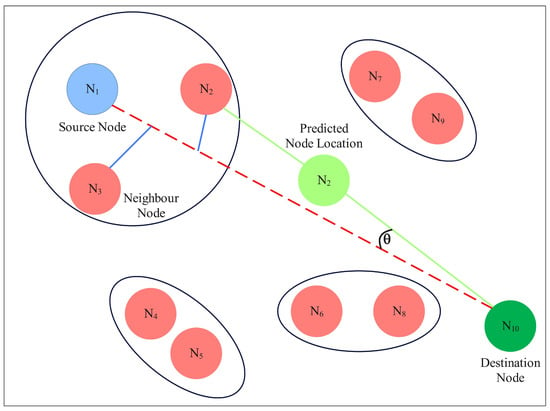
Figure 1.
Illustration of nodes, line of sight (LoS), predicted position, and distance/angular calculations for routing decision.
Figure 1 illustrates the scenario considered for the HBRO and AEProphet routing protocols. In this figure, the source node is represented by a blue-filled circle, while the destination node is depicted as a green-filled circle. The predicted location of node is indicated by a light green circle, and the neighboring node is shown as a pink circle. A red dotted line connects the source and destination nodes, representing a line-of-sight (LoS) link. Additionally, the blue line indicates the perpendicular distance from the neighbor node to the LoS line. An angle is measured between the LoS line and the predicted location of node . The primary objective of both HBRP and AEProphet is to identify the optimal neighbor node to serve as the next hop for forwarding data from the source to the destination in an opportunistic manner.
The selection of the next hop comprises three parameters: (i) the node’s movement stability, (ii) the node’s direction prediction, and (iii) the neighbor node distance from the LoS line between the source and destination (this distance is measured perpendicularly). The node’s stability () is related to the history table, which contains two parameters, namely the time and location of the node. Based on time and location information, the node by itself can calculate the average speed attained by it during the transition from one location to another. This provides insight into whether a node is stable or not in its movement. A high average speed shows the unstable movement of the node, while a low average speed shows that the node’s movement is stable. For node movement direction (), a Markov predictor can be applied, which can predict the next direction by analyzing the previous visit’s pattern [20,21]. Finally, the perpendicular distance () of the neighbor node from the source-to-destination line (SDL) is measured; this provides the closeness of a neighbor node to the SDL.
The closer a neighborhood node is to the SDL, the less distance will be required to forward a data packet to the destination. A utility function can be computed using Equation (1), in which comprises a vector containing the node characteristics, defined as , and shows the ith vehicle with kth parameter . After calculating , a threshold T is utilized to select the neighbor as the next-hop node. The main problem with both algorithms, i.e., HBRP and AEProphet, is that they are always in the process of finding the optimal neighbor as the next hop to forward the data to the destination and overlook the potential of direct communication in case the selection of the neighbor node takes a longer time. This study suggests direct communication between the source and destination if the aforementioned protocols are stuck in the problem of finding the optimal neighbor node as the next hop. When the next-hop selection time reaches a certain limit, then the node should employ direct communication, and if the source node finds the optimal neighbor node before exceeding the threshold for next-hop selection time, then it should perform the node-to-node communication as per routine.
The proposed methodology is presented in Figure 2. In Figure 2, the network and assumptions of the routing protocols are initialized at the start. After that, the next hop is selected using a predefined utility matrix, such as the HBRP algorithm, or following predefined AEProphet algorithm steps to forward the data to the destination. However, these algorithms get activated after finding a suitable next hop. Since these algorithms fully rely on device-to-device (D2D) communication, there is the possibility of getting stuck waiting for the selection of the suitable next hop. Due to such hindrance, significant degradation in the average energy and overhead ratio can be observed, along with an increase in dead nodes. To tackle such hindrances, we proposed utilizing LoS communication. It is also important to note that if the next hop is selected before the threshold limit, then the existing routing protocols are utilized and no LoS communication is utilized. The purpose of LoS communication is to avoid long delays when existing protocols stall.
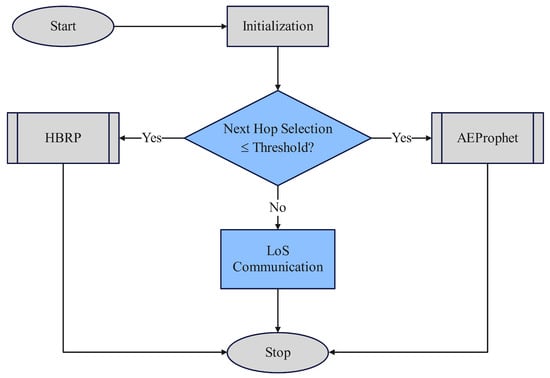
Figure 2.
Flowchart of proposed hybrid routing model with LoS fallback mechanism.
The rationale for selecting the HBRP and AEProphet algorithms as baseline protocols lies in their representative characteristics, namely their reliance on history-based and context-aware mechanisms. Both schemes forward content or data to the next node using either historical knowledge or various contextual features. These protocols relay data messages to the destination by selecting an appropriate neighboring node, which offers significant benefits for delay-tolerant applications. However, they also present a critical limitation: the risk of becoming stuck when no suitable next-hop neighbor is readily available, leading to excessive time consumption during the forwarding process. This issue could potentially be mitigated if nodes have the ability to communicate directly using a line-of-sight (LoS) connection. The proposed scheme is designed to enable meaningful comparisons by evaluating the impact of LoS-based enhancements under realistic mobility scenarios, in contrast to the existing protocols.
4. Simulation Environment and Results
In this section, we will provide a complete description of the simulation setup and the simulation results achieved by our proposed methodology.
4.1. Simulation Environment Assumptions
This section outlines the assumptions of the simulation environment to enhance the clarity and understanding of the underlying system, the existing schemes, and the consistent advantages offered by the proposed approaches.
- LoS: LoS communication is initiated when the time to select a next hop exceeds the threshold T seconds.
- : Angle between predicted direction and SDL (source–destination line).
- : Perpendicular distance of neighbor node from SDL.
- : Stability measured using speed variance.
- State Assumption: We assume an open area without signal obstruction to allow uninterrupted LoS transmission.
4.2. Simulation Setup
To evaluate the proposed methodology, the ONE simulator [22] is utilized, incorporating mobile nodes that operate at varying speeds. Some nodes share the same home location, while others are initialized with different starting points. Each node is capable of communicating within a range of 10 m. The nodes generate messages with sizes ranging from 500 KB to 1 MB at intervals of 25 to 35 s. They are organized into six distinct communities, each with its own home location, where every node begins its operation. The mobility of a node to its home location, as well as to other locations, can be characterized by the probabilities p and , respectively. In the simulation setup, a threshold is varied to assess the number of delivered messages and the overhead ratio.
The performance metrics employed in this study are outlined as follows.
- Number of delivered messages: It is measured as the total number of successful messages delivered to the destination.
- Number of dead nodes: If the remaining energy of the node is less than a certain value, it is referred to as a dead node.
- Overhead ratio: It is used to measure the number of average copies forwarded per message.
4.3. Simulation Results
Figure 3 illustrates the number of delivered messages in comparison to the threshold values computed by the utility function. At lower threshold values, such as 0.2 to 0.3, fewer messages are delivered. This lower delivery rate can be attributed to the node’s instability and its perpendicular distance from the SD line. Additionally, a low prediction capability of the Markov process may contribute to the reduced performance in message delivery. As the threshold values increase from 0.3 to 0.7, the number of delivered messages also rises. This improvement can be attributed to the increased stability of the node, enhanced predictive performance for determining the next-hop location, and the node’s proximity to the SD line. Consequently, higher threshold values result in a greater number of delivered messages, as shown in Figure 3.
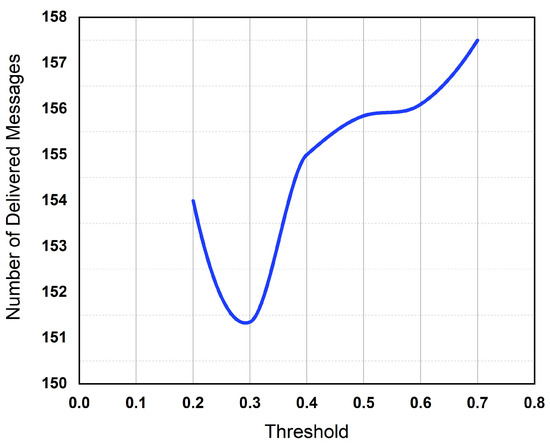
Figure 3.
Number of delivered messages under varying threshold values using proposed model.
It is also important to note that the trends observed in Figure 3, Figure 4, Figure 5, Figure 6, Figure 7 and Figure 8 result from the utility function described in Equation (1) and its integration with line-of-sight (LoS) communication. The utility function, as presented in Equation (1), is formulated based on several factors, including the node’s mobility pattern, stability, direction, and its distance from the source-to-destination path. These parameters collectively influence the selection of the most suitable next-hop node for data forwarding. The simulation results—evaluated against various threshold values, node counts, message sizes, and mobility models—are directly correlated with key performance indicators such as delivery ratio, number of dead nodes, and average residual energy of the nodes in the network.
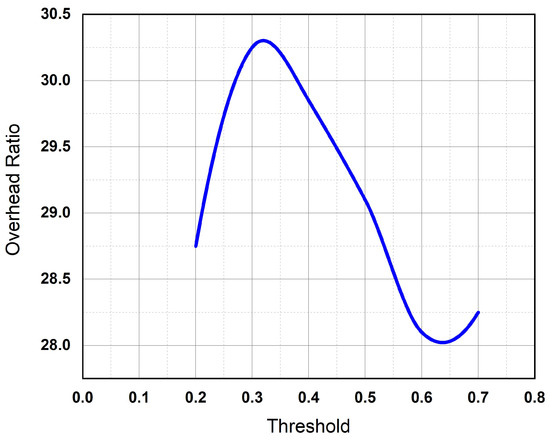
Figure 4.
Overhead ratio under varying threshold values using the proposed model.
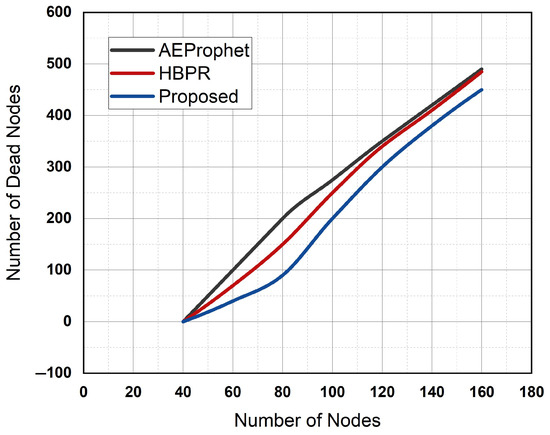
Figure 5.
Number of dead nodes vs. number of nodes.
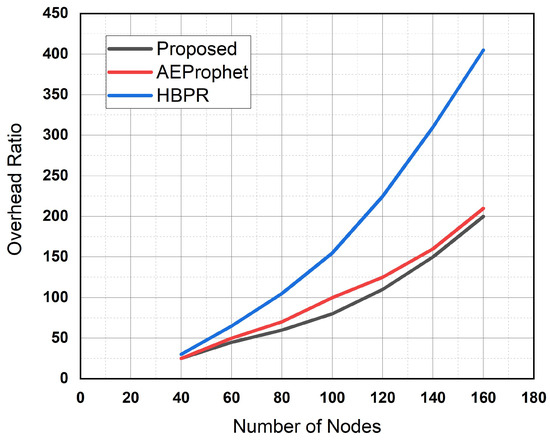
Figure 6.
Overhead ratio of proposed and existing algorithms.
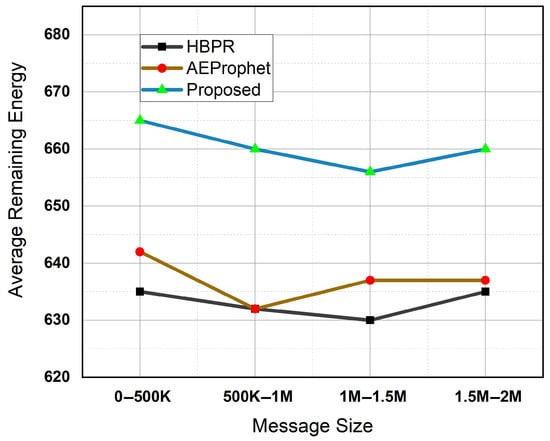
Figure 7.
Average remaining energy vs. message size.
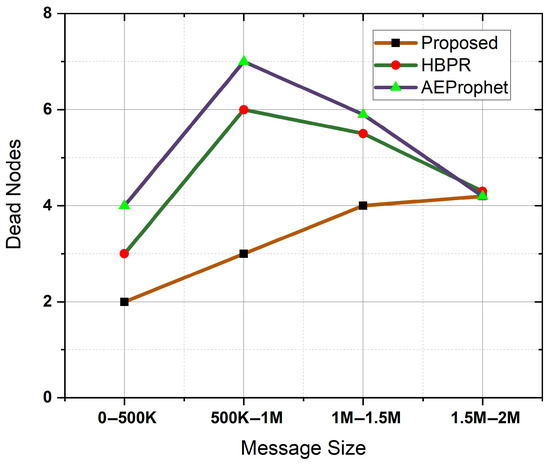
Figure 8.
Dead nodes vs. message size.
Figure 4 shows the performance of the proposed methodology in terms of the overhead ratio compared to the threshold. Initially, the overhead ratio increases for threshold values ranging from 0.2 to 0.33 and then decreases until reaching a threshold value of 0.6. The increase in overhead ratio can be attributed to the lower number of delivered messages, which necessitates higher retransmissions of message packets. However, as the threshold values increase, the number of delivered messages also rises, ultimately leading to a reduction in message retransmissions and, consequently, a lower overhead ratio.
Existing routing protocols in DTNs aim to identify the next suitable node for message forwarding until the message ultimately reaches its destination. Nodes in the network buffer receive data and expend energy during the process of discovering the next hop. However, this discovery process can lead to energy depletion in some nodes—particularly in battery-powered IoT devices—causing them to shut down and become non-functional, or ’dead’ nodes. This situation underscores the critical importance of considering the energy status of each node in routing decisions to prevent premature node failure. The proposed routing schemes specifically address this concern by incorporating energy-awareness into the decision-making process. Furthermore, when the next-hop discovery process surpasses predefined thresholds, the proposed schemes explore alternative solutions, such as utilizing LoS communication, to ensure reliable message delivery while preserving node functionality. The number of dead nodes for the proposed scheme (blue-colored solid line), HBRP (red-colored solid line), and AEProphet (black-colored solid line) is shown in Figure 5. Due to the incorporation of LoS communication in the proposed scheme, the number of dead nodes is less than in the existing algorithms, such as HBRP and AEProphet. In existing routing protocols the dead nodes are due to only considering D2D communication and finding the next hop caused by the algorithmic process. The long waiting time in selecting the next hop results in higher energy consumption of the node. In this way, the proposed scheme saves several nodes from experiencing the dead condition.
Figure 6 illustrates the performance of the overhead ratio parameters of the proposed scheme compared to existing schemes. The proposed scheme demonstrates a lower overhead ratio compared to the HBRP and AEProphet algorithms. The overhead issue remains minimal when the number of nodes is relatively small, specifically within the range of 40 to 80 nodes. However, as the number of nodes increases from 80 to 160 the HBRP algorithm exhibits an exponential increase in the overhead ratio, while the AEProphet algorithm maintains a lower overhead ratio. In comparison to both existing schemes, the proposed scheme consistently shows a lower overhead ratio across all node ranges examined in this study. This performance can be attributed to the incorporation of line-of-sight (LoS)-based communication, which minimizes delays in next-hop selection. Furthermore, the proposed scheme also performs excellently as the message size increases. It enhances the average energy efficiency by nearly 4% compared to the existing HBRP and AEProphet algorithms. The proposed scheme and AEProphet exhibit a similar overhead ratio, as both approaches employ comparable context-aware routing strategies that limit redundant message forwarding. However, beyond a certain threshold, the proposed scheme leverages LoS communication, which effectively reduces retransmissions and buffer load. This results in a performance divergence, with the proposed scheme demonstrating superior overhead efficiency.
Figure 7 illustrates the performance of the average energy of the nodes for both the proposed scheme and the existing scheme, comparing average energy consumption against message size. The proposed scheme mitigates the issue of node congestion in selecting the next hop, ultimately leading to lower energy consumption. In contrast, existing algorithms consistently identify the next hop to forward the message to its destination, which can introduce delays. During the next-hop selection process, nodes must retain messages in their buffers while continuing to search for the appropriate next hop for forwarding. This reliance on redundant message copies in existing algorithms results in higher energy consumption, ultimately leading to a decrease in the average energy of the nodes. Conversely, the proposed scheme effectively maintains average energy levels, thereby ensuring a lower number of dead nodes.
Figure 8 illustrates the performance of the proposed scheme compared to existing schemes in terms of dead nodes versus message size changes. The existing schemes exhibit a higher occurrence of dead nodes as the message size increases, particularly within the range of 0 to 1.5 MB; meanwhile, the proposed scheme illustrates a lower number of dead nodes in the network. As the message size increases from a specific point, such as 1.5 MB, the proposed schemes show a rise in dead nodes, which could be attributed to higher message processing of the message, thereby increasing energy consumption.
5. Conclusions
Existing routing protocols in OppNets, such as HBRP and AEProphet, face significant challenges in selecting the optimal next-hop node during message forwarding. This difficulty arises due to various factors, including node mobility, energy constraints, geographic location, and the perpendicular distance from the source-to-destination trajectory. These dynamics make efficient next-node selection a complex task. However, the opportunistic nature of message forwarding helps maintain network connectivity by preventing nodes from becoming inactive or “dead.” In this study, we propose a method that leverages line-of-sight (LoS) communication when traditional next-hop selection becomes inefficient, as observed in existing schemes. By introducing a threshold-based LoS mechanism, the proposed approach enhances the message delivery ratio, reduces communication overhead, and conserves node energy. Collectively, these improvements contribute to overall network performance and reliability. We selected HBRP and AEProphet for evaluation due to their context- and history-aware characteristics, which closely align with the operational context of the proposed scheme. In future work, we intend to extend the evaluation by incorporating additional protocols such as epidemic routing (ER) and Spray-and-Wait. Future work will address urban and obstacle-rich environments.
Author Contributions
Conceptualization, A.M. and M.N.A.; methodology, A.M., M.N.A., A.I., and B.-S.K.; validation, M.N.A., A.M., and B.-S.K.; formal analysis, A.I. and A.M.; investigation, M.N.A., A.M., and B.-S.K.; resources, B.-S.K.; writing—original draft preparation, A.M. and M.N.A.; writing—review editing, M.N.A. and B.-S.K.; supervision, B.-S.K.; funding acquisition, B.-S.K. All authors have read and agreed to the published version of the manuscript.
Funding
This research received no external funding.
Data Availability Statement
This study includes all the data used in this work.
Acknowledgments
This work was supported by the National Research Foundation of Korea (NRF) grant funded by the Korean government (MSIT) (No. RS-2022-NR069069).
Conflicts of Interest
The authors declare no conflicts of interest.
Abbreviations
The following abbreviations are used in this manuscript:
| OppNets | Opportunistic Networks |
| MANETs | Mobile Ad Hoc Networks |
| QoS | Quality of service |
| LoS | Line of sight |
| HBRP | History-based routing protocol |
| DTNs | Delay-Tolerant Networks |
| ER | Epidemic routing |
| PRoPHET | Probabilistic Routing Protocol |
| CAR | Context-aware routing |
References
- Tikhonov, E.; Schneps-Schneppe, D.; Namiot, D. Delay Tolerant Network protocols for an Expanding Network on a Railway. In Proceedings of the 2020 International Conference on Innovation and Intelligence for Informatics, Computing and Technologies (3ICT), Sakheer, Bahrain, 20–21 December 2020; pp. 1–6. [Google Scholar] [CrossRef]
- Ambreen, N.H. Wireless sensor network through shortest path route. Int. J. Emerg. Technol. Adv. Eng. 2013, 3, 158–161. [Google Scholar]
- Avoussoukpo, C.B.; Ogunseyi, T.B.; Tchenagnon, M. Securing and Facilitating Communication Within Opportunistic Networks: A Holistic Survey. IEEE Access 2021, 9, 55009–55035. [Google Scholar] [CrossRef]
- Memon, A.; Nazir, M.A.; Hamid, K.; Iqbal, M.W. An Efficient Approach for Data Transmission Using the Encounter Prediction. Work 2013, 7, 9. [Google Scholar]
- Mathew, R.; Amrutha, P.V.; Sahoo, S.; Kovoor, B.C.; Nijagunarya, Y. MANET with Opportunistic Auto-Rate Anthocnet Protocol. In Proceedings of the 2020 International Conference on Recent Trends on Electronics, Information, Communication & Technology (RTEICT), Bangalore, India, 12–13 November 2020; pp. 98–103. [Google Scholar] [CrossRef]
- Memon, A.; Liu, W.; Al-Anbuky, A. Catchme if you can: Enable sustainable communications using Internet of movable things. In Proceedings of the 2016 IEEE 14th International Conference on Dependable, Autonomic and Secure Computing, 14th International Conference on Pervasive Intelligence and Computing, 2nd International Conference on Big Data Intelligence and Computing and Cyber Science and Technology Congress (DASC/PiCom/DataCom/CyberSciTech), Auckland, New Zealand, 8–12 August 2016; pp. 947–952. [Google Scholar]
- Sui, Z. The Research of the Route Protocols in Opportunistic Network. In Proceedings of the 2015 International Conference on Computational Intelligence and Communication Networks (CICN), Jabalpur, India, 12–14 December 2015; pp. 192–196. [Google Scholar] [CrossRef]
- Memon, A.; Ali, M.N.; Kim, B.S. A Sustainable Data Dissemination Approach by Utilizing the Internet of Moving Things. IEEE Access 2024, 12, 26581–26590. [Google Scholar] [CrossRef]
- Huang, C.-M.; Lan, K.-c.; Tsai, C.-Z. A Survey of Opportunistic Networks. In Proceedings of the 22nd International Conference on Advanced Information Networking and Applications-Workshops (Aina Workshops 2008), Gino-wan, Japan, 25–28 March 2008; pp. 1672–1677. [Google Scholar] [CrossRef]
- Qasim, A.; Ghouri, A.; Munawar, A. An effective approach for reducing data redundancy in multi-agent system communication. Multiagent Grid Syst. 2024, 20, 69–88. [Google Scholar] [CrossRef]
- Zhang, Y.; Han, Y.; Li, J.; Wu, P. Community Detection Using Maximum Connection Probability in Opportunistic Network. In Proceedings of the 2013 4th International Conference on Intelligent Systems, Modelling and Simulation, Bangkok, Thailand, 29–31 January 2013; pp. 475–480. [Google Scholar] [CrossRef][Green Version]
- Feng, G.; Qin, X.; Jia, Z.; Li, S. Energy efficiency resource allocation for D2D communication network based on relay selection. Wirel. Netw. 2021, 27, 3689–3699. [Google Scholar] [CrossRef]
- Pang, X.; Liu, M.; Li, Z.; Gao, B.; Guo, X. Geographic Position based Hopless Opportunistic Routing for UAV networks. Ad Hoc Netw. 2021, 120, 102560. [Google Scholar] [CrossRef]
- Gao, J.; Guibas, L.J.; Hershberger, J.; Zhang, L.; Zhu, A. Geometric spanner for routing in mobile networks. In Proceedings of the 2nd ACM International Symposium on Mobile Ad Hoc Networking & Computing, Long Beach, CA, USA, 4–5 October 2001; pp. 45–55. [Google Scholar]
- Kim, Y.J.; Govindan, R.; Karp, B.; Shenker, S. Geographic routing made practical. In Proceedings of the 2nd Conference on Symposium on Networked Systems Design & Implementation-Volume 2, Boston, MA, USA, 2–4 May 2005; pp. 217–230. [Google Scholar]
- Lindgren, A.; Doria, A.; Schelén, O. Probabilistic routing in intermittently connected networks. ACM SIGMOBILE Mob. Comput. Commun. Rev. 2003, 7, 19–20. [Google Scholar] [CrossRef]
- Boldrini, C.; Conti, M.; Jacopini, J.; Passarella, A. Hibop: A history based routing protocol for opportunistic networks. In Proceedings of the 2007 IEEE International Symposium on a World of Wireless, Mobile and Multimedia Networks, Espoo, Finland, 18–21 June 2007; pp. 1–12. [Google Scholar]
- Musolesi, M.; Hailes, S.; Mascolo, C. Adaptive routing for intermittently connected mobile ad hoc networks. In Proceedings of the Sixth IEEE International Symposium on a World of Wireless Mobile and Multimedia Networks, Taormina-Giardini Naxos, Italy, 16 June 2005; pp. 183–189. [Google Scholar]
- Ji, Y.; Huang, Y.; Yang, M.; Leng, H.; Ren, L.; Liu, H.; Chen, Y. Physics-informed deep learning for virtual rail train trajectory following control. Reliab. Eng. Syst. Saf. 2025, 261, 111092. [Google Scholar] [CrossRef]
- Xuehui, D.; Yadi, W.; Xingyuan, C.; Zhen, W. Research on DTN data forwarding algorithm based on node’s position and moving direction. In Proceedings of the 2011 International Conference on Consumer Electronics, Communications and Networks (CECNet), Xianning, China, 16–18 April 2011; pp. 1581–1585. [Google Scholar] [CrossRef]
- Ahmad, M.; Ali, M.; Naeem, M.; Ahmed, A.; Iqbal, M.; Ejaz, W.; Anpalagan, A. Device-centric communication in IoT: An energy efficiency perspective. Trans. Emerg. Telecommun. Technol. 2020, 31, e3750. [Google Scholar] [CrossRef]
- Keränen, A.; Ott, J.; Kärkkäinen, T. The ONE Simulator for DTN Protocol Evaluation. In Proceedings of the 2nd International Conference on Simulation Tools and Techniques, Simutools ’09, Rome, Italy, 2–6 March 2009. [Google Scholar] [CrossRef]
Disclaimer/Publisher’s Note: The statements, opinions and data contained in all publications are solely those of the individual author(s) and contributor(s) and not of MDPI and/or the editor(s). MDPI and/or the editor(s) disclaim responsibility for any injury to people or property resulting from any ideas, methods, instructions or products referred to in the content. |
© 2025 by the authors. Licensee MDPI, Basel, Switzerland. This article is an open access article distributed under the terms and conditions of the Creative Commons Attribution (CC BY) license (https://creativecommons.org/licenses/by/4.0/).